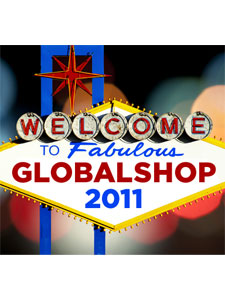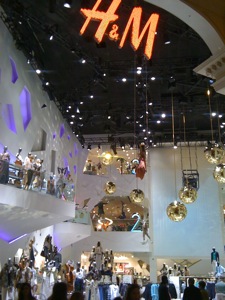Lessons from GlobalShop 2011


Last week I had the privilege of attending the GlobalShop show in Las Vegas. GlobalShop is the world’s largest annual event for retail design and shopper marketing. It boasts the largest, most comprehensive array of store fixtures, lighting, retail technology and other in-store solutions in the US.
The show provided a great opportunity to see the latest trends in retail merchandising and design, and learn from some of the leaders in the industry. Here are a few takeaways from my time there:
Technology integration is HUGE. The giant kiosks of a few years ago are passe, but tablets and iPads are making their way onto retail floors extremely quickly. LCD screens and interactive displays are becoming commonplace in new retail designs. QR codes are everywhere. 6.4% of all retail buying is happening online (Javeline Strategy & Research, Feb. 2011), but 42% of consumers say that they spend half or more of their "shopping time" doing research online before heading to a store to buy. 97% of shoppers search the web for LOCAL products and services (BIA/Kelsey 2010). In other words, a company's website is becoming increasingly important even if you don't sell a single product online. You think mobile e-commerce will never take off? Last year more than $2 Billion worth of product was purchased on eBay via mobile phones!
Customers are searching for meaning. Even WalMart is starting to market more and more products based on their story and not just their price. Whereas the talk in years past was about an efficient Supply Chain, more and more focus is being paid to the Value Chain. Retailers want to be seen as carefully selecting the perfect pieces from manufacturers, growers or designers that have a romantic story to tell. Target was one of the early adopters of this approach in the Mass Market with their Isaac Mizrahi collections. Now everyone is getting in on the game.
Customers are searching for a rush. Scientists have been studying shoppers for years, and there is a measurable Dopamine Rush associated with discovery, new experiences, and new purchases. The same high (and it really is a chemical high) that a new customer experiences when discovering a tea shop with great sights and smells and experiences, prevents many of those same customers from returning to your store!! Not to put too blunt a point on it, but once they've had you, many customers will immediately find you boring and are off looking for the next high. Retailers are investing a great deal of energy and money into creating new experiences and rapidly delivering new products to keep customers coming back.
Emotion is the reason we buy things we don't need. A very small percentage of the consumption that happens in the US is based on real need. A very large percentage is based on emotion. I want it. It makes me feel good. The logical reasons for a purchase (features and benefits, pricing, quality, etc.) are taking a back seat to the emotional connection that people have with a concept, product or brand. Picture a teenager getting their first laptop. Dad brings it home and unveils a bright shiny PC with a twinkle in his eye. "Dude, you're getting a Dell!" :-D The crestfallen teen replies, "But Dad, I'm a MAC!". I'm a Mac. Not Macs are better, faster, or even cooler. No. "I AM a Mac."
Store brands are cool. The trend towards emotional brand association discussed above has been adopted by many large retailers and the number of private label products is increasing rapidly. Brands like Target, Ikea, Trader Joe's and Whole Foods have moved private label products from the negative perception of "generics" to an overwhelmingly positive image in the minds of consumers. Today, 80% of consumers across all demographics believe that store brands are AS GOOD if not BETTER than national brands (Stein LLC).
Retailers are shrinking. Having reached the end of the runway on rapid expansion of mega-stores, and with the slow but steady decline of consumer traffic at shopping malls, retailers are rolling out smaller more targeted concepts. Once again, even WalMart has recently announced smaller stores targeting high density urban markets. The overall trend is away from big box and department stores, and towards specialty retailers.
That's one trend I can get on board with. :)
There are quite a few more tactical lessons and strategies I picked up along the way... things like how much money can be saved by manufacturing our fixtures in China, how LED lighting can save me a fortune on HVAC, and ideas for dramatically improving our teaware merchandising, but I'll save those for future posts. I've identified several new strategies that I think will be key to Adagio's retail growth and success. I am VERY excited. :-D
Adagio Teas
Twitter: @AdagioRetail
